Impact of Employee Resistance to Change: A Tesco UK Retail Study
VerifiedAdded on 2023/06/07
|17
|4924
|390
Project
AI Summary
This project delves into the critical issue of employee resistance to change within the UK retail industry, using Tesco as a case study. The research begins with an introduction that outlines the background, aims, objectives, research questions, problem statement, rationale, and significance of the study. A comprehensive literature review explores the concept of employee resistance, analyzes its impact within the UK retail sector, and identifies strategies to mitigate its effects. The research methodology chapter details the research philosophy, approach, strategy, choice, time horizon, data collection methods, sampling techniques, and ethical considerations. The data analysis chapter presents findings, followed by conclusions and recommendations. The project examines the causes of resistance, such as fear of job loss, and its consequences, including staff turnover and financial costs. It proposes strategies like communication, training, and support to reduce resistance and improve organizational outcomes. The study aims to understand how Tesco can minimize the negative impacts of employee resistance and adapt to changes in the competitive environment.
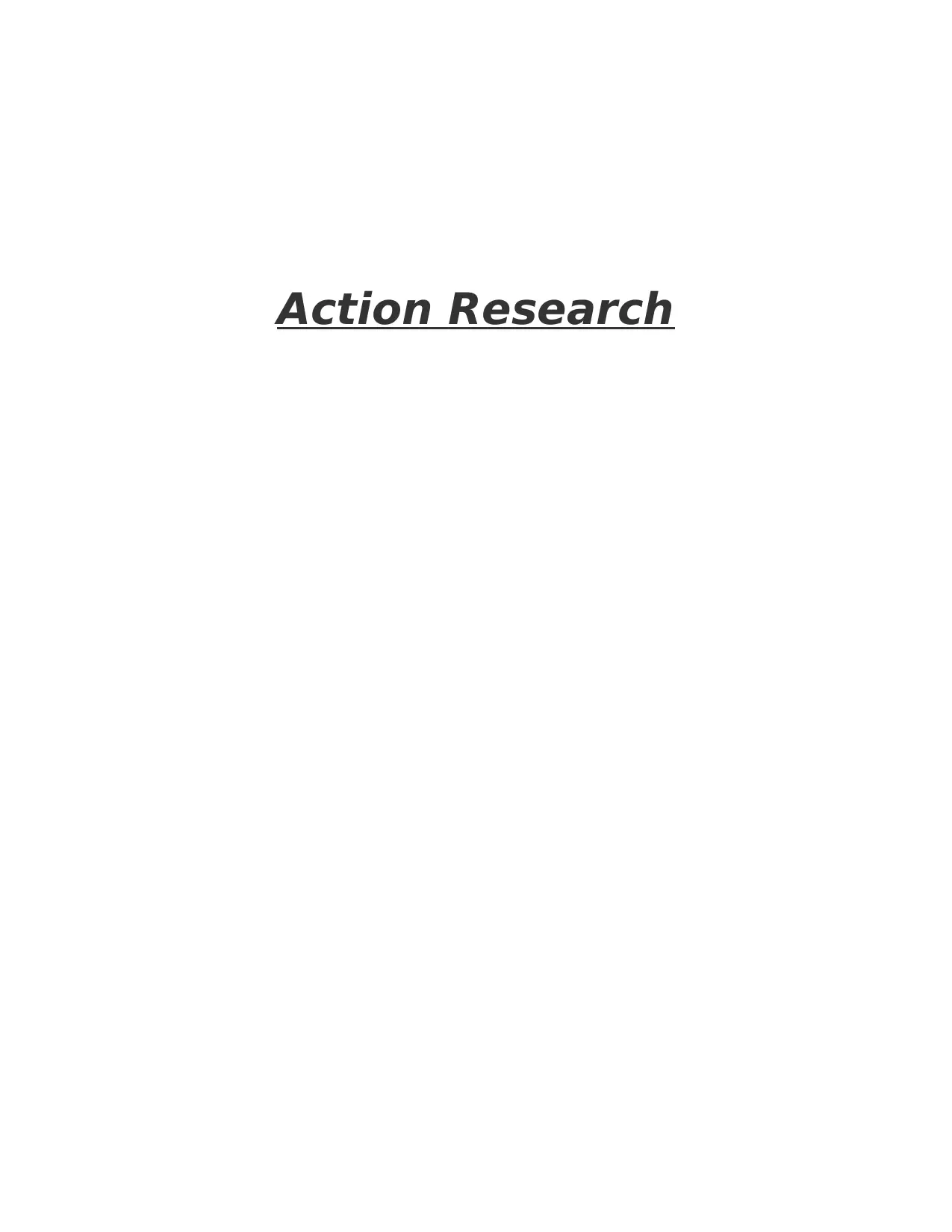
Action Research
Paraphrase This Document
Need a fresh take? Get an instant paraphrase of this document with our AI Paraphraser
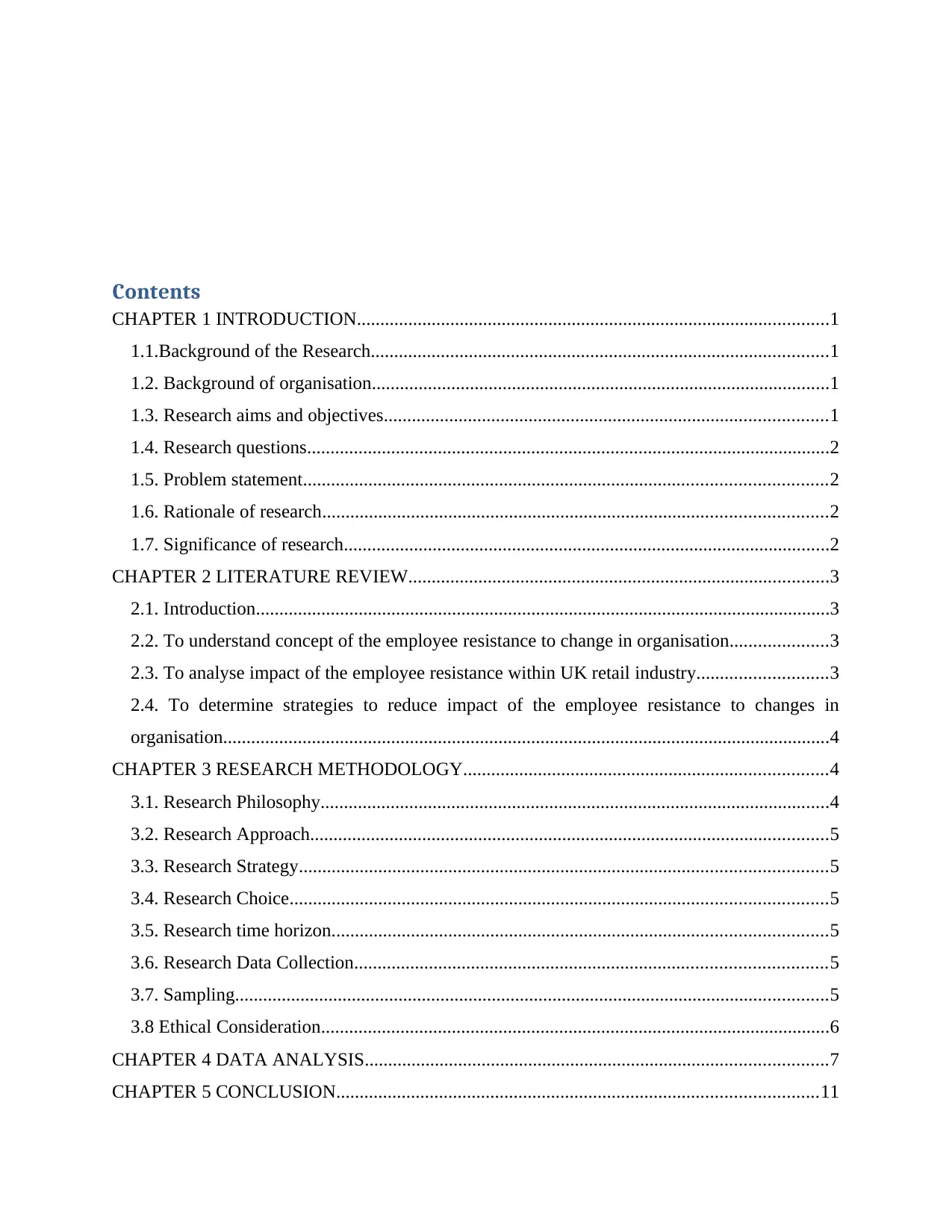
Contents
CHAPTER 1 INTRODUCTION.....................................................................................................1
1.1.Background of the Research..................................................................................................1
1.2. Background of organisation..................................................................................................1
1.3. Research aims and objectives...............................................................................................1
1.4. Research questions................................................................................................................2
1.5. Problem statement................................................................................................................2
1.6. Rationale of research............................................................................................................2
1.7. Significance of research........................................................................................................2
CHAPTER 2 LITERATURE REVIEW..........................................................................................3
2.1. Introduction...........................................................................................................................3
2.2. To understand concept of the employee resistance to change in organisation.....................3
2.3. To analyse impact of the employee resistance within UK retail industry............................3
2.4. To determine strategies to reduce impact of the employee resistance to changes in
organisation..................................................................................................................................4
CHAPTER 3 RESEARCH METHODOLOGY..............................................................................4
3.1. Research Philosophy.............................................................................................................4
3.2. Research Approach...............................................................................................................5
3.3. Research Strategy.................................................................................................................5
3.4. Research Choice...................................................................................................................5
3.5. Research time horizon..........................................................................................................5
3.6. Research Data Collection.....................................................................................................5
3.7. Sampling...............................................................................................................................5
3.8 Ethical Consideration.............................................................................................................6
CHAPTER 4 DATA ANALYSIS...................................................................................................7
CHAPTER 5 CONCLUSION.......................................................................................................11
CHAPTER 1 INTRODUCTION.....................................................................................................1
1.1.Background of the Research..................................................................................................1
1.2. Background of organisation..................................................................................................1
1.3. Research aims and objectives...............................................................................................1
1.4. Research questions................................................................................................................2
1.5. Problem statement................................................................................................................2
1.6. Rationale of research............................................................................................................2
1.7. Significance of research........................................................................................................2
CHAPTER 2 LITERATURE REVIEW..........................................................................................3
2.1. Introduction...........................................................................................................................3
2.2. To understand concept of the employee resistance to change in organisation.....................3
2.3. To analyse impact of the employee resistance within UK retail industry............................3
2.4. To determine strategies to reduce impact of the employee resistance to changes in
organisation..................................................................................................................................4
CHAPTER 3 RESEARCH METHODOLOGY..............................................................................4
3.1. Research Philosophy.............................................................................................................4
3.2. Research Approach...............................................................................................................5
3.3. Research Strategy.................................................................................................................5
3.4. Research Choice...................................................................................................................5
3.5. Research time horizon..........................................................................................................5
3.6. Research Data Collection.....................................................................................................5
3.7. Sampling...............................................................................................................................5
3.8 Ethical Consideration.............................................................................................................6
CHAPTER 4 DATA ANALYSIS...................................................................................................7
CHAPTER 5 CONCLUSION.......................................................................................................11
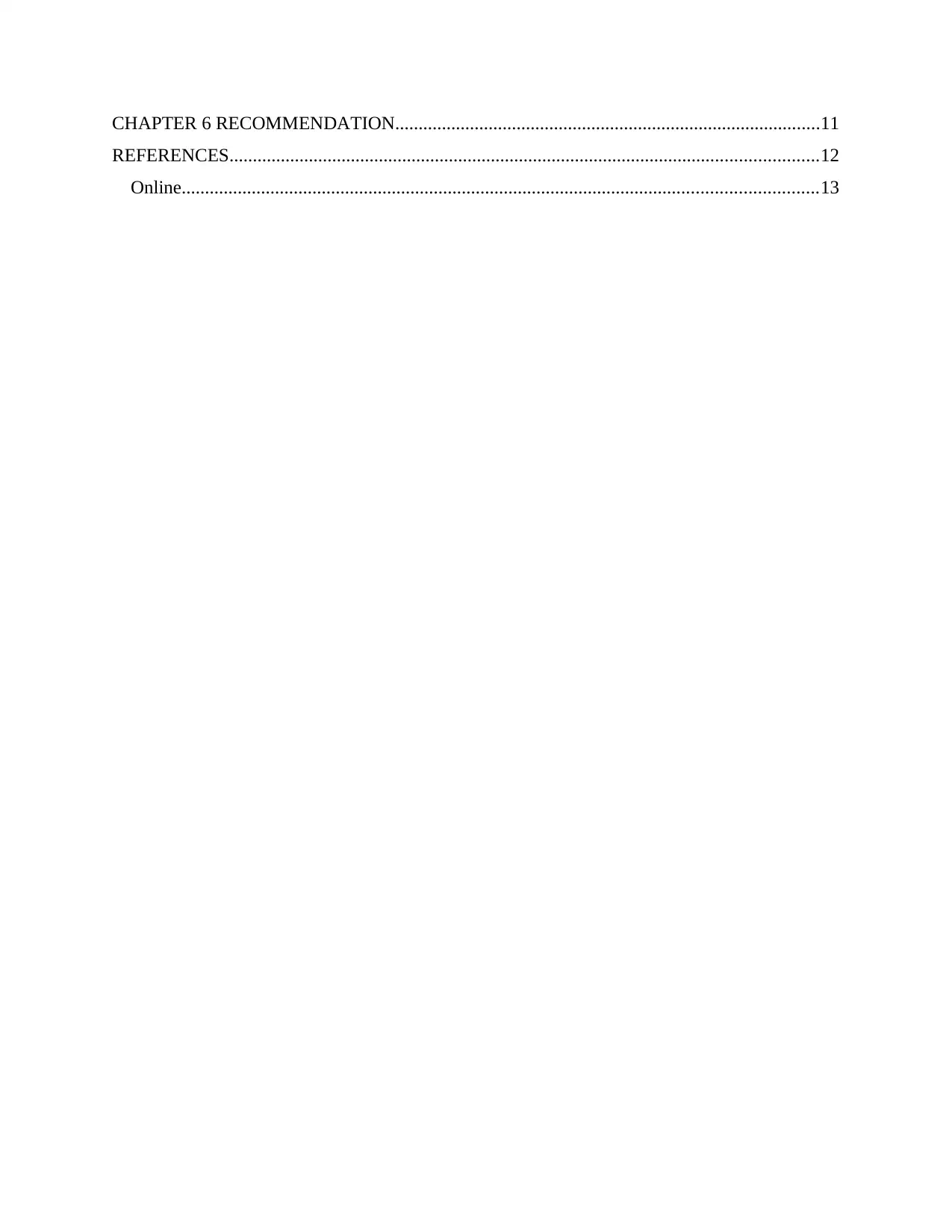
CHAPTER 6 RECOMMENDATION...........................................................................................11
REFERENCES..............................................................................................................................12
Online........................................................................................................................................13
REFERENCES..............................................................................................................................12
Online........................................................................................................................................13
⊘ This is a preview!⊘
Do you want full access?
Subscribe today to unlock all pages.

Trusted by 1+ million students worldwide
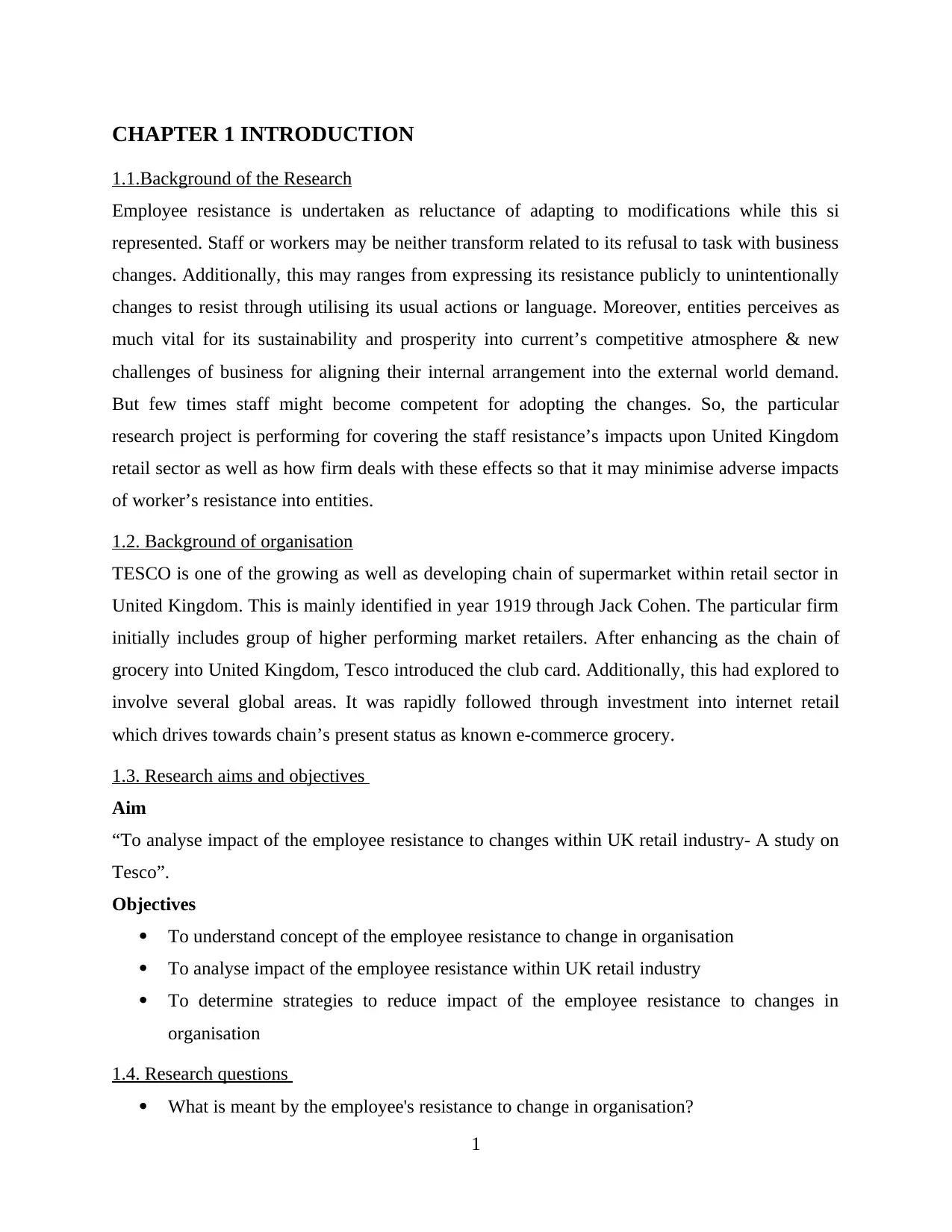
CHAPTER 1 INTRODUCTION
1.1.Background of the Research
Employee resistance is undertaken as reluctance of adapting to modifications while this si
represented. Staff or workers may be neither transform related to its refusal to task with business
changes. Additionally, this may ranges from expressing its resistance publicly to unintentionally
changes to resist through utilising its usual actions or language. Moreover, entities perceives as
much vital for its sustainability and prosperity into current’s competitive atmosphere & new
challenges of business for aligning their internal arrangement into the external world demand.
But few times staff might become competent for adopting the changes. So, the particular
research project is performing for covering the staff resistance’s impacts upon United Kingdom
retail sector as well as how firm deals with these effects so that it may minimise adverse impacts
of worker’s resistance into entities.
1.2. Background of organisation
TESCO is one of the growing as well as developing chain of supermarket within retail sector in
United Kingdom. This is mainly identified in year 1919 through Jack Cohen. The particular firm
initially includes group of higher performing market retailers. After enhancing as the chain of
grocery into United Kingdom, Tesco introduced the club card. Additionally, this had explored to
involve several global areas. It was rapidly followed through investment into internet retail
which drives towards chain’s present status as known e-commerce grocery.
1.3. Research aims and objectives
Aim
“To analyse impact of the employee resistance to changes within UK retail industry- A study on
Tesco”.
Objectives
To understand concept of the employee resistance to change in organisation
To analyse impact of the employee resistance within UK retail industry
To determine strategies to reduce impact of the employee resistance to changes in
organisation
1.4. Research questions
What is meant by the employee's resistance to change in organisation?
1
1.1.Background of the Research
Employee resistance is undertaken as reluctance of adapting to modifications while this si
represented. Staff or workers may be neither transform related to its refusal to task with business
changes. Additionally, this may ranges from expressing its resistance publicly to unintentionally
changes to resist through utilising its usual actions or language. Moreover, entities perceives as
much vital for its sustainability and prosperity into current’s competitive atmosphere & new
challenges of business for aligning their internal arrangement into the external world demand.
But few times staff might become competent for adopting the changes. So, the particular
research project is performing for covering the staff resistance’s impacts upon United Kingdom
retail sector as well as how firm deals with these effects so that it may minimise adverse impacts
of worker’s resistance into entities.
1.2. Background of organisation
TESCO is one of the growing as well as developing chain of supermarket within retail sector in
United Kingdom. This is mainly identified in year 1919 through Jack Cohen. The particular firm
initially includes group of higher performing market retailers. After enhancing as the chain of
grocery into United Kingdom, Tesco introduced the club card. Additionally, this had explored to
involve several global areas. It was rapidly followed through investment into internet retail
which drives towards chain’s present status as known e-commerce grocery.
1.3. Research aims and objectives
Aim
“To analyse impact of the employee resistance to changes within UK retail industry- A study on
Tesco”.
Objectives
To understand concept of the employee resistance to change in organisation
To analyse impact of the employee resistance within UK retail industry
To determine strategies to reduce impact of the employee resistance to changes in
organisation
1.4. Research questions
What is meant by the employee's resistance to change in organisation?
1
Paraphrase This Document
Need a fresh take? Get an instant paraphrase of this document with our AI Paraphraser
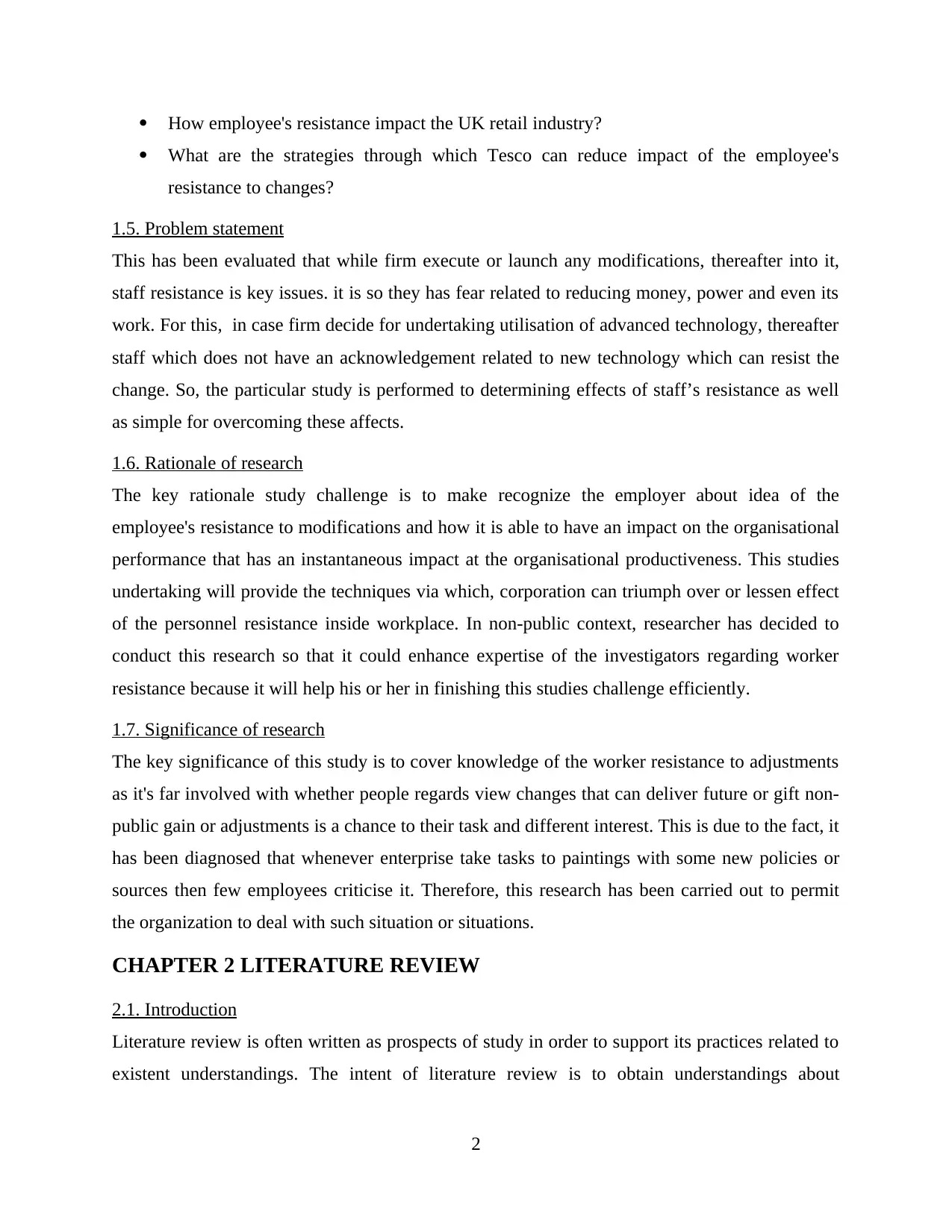
How employee's resistance impact the UK retail industry?
What are the strategies through which Tesco can reduce impact of the employee's
resistance to changes?
1.5. Problem statement
This has been evaluated that while firm execute or launch any modifications, thereafter into it,
staff resistance is key issues. it is so they has fear related to reducing money, power and even its
work. For this, in case firm decide for undertaking utilisation of advanced technology, thereafter
staff which does not have an acknowledgement related to new technology which can resist the
change. So, the particular study is performed to determining effects of staff’s resistance as well
as simple for overcoming these affects.
1.6. Rationale of research
The key rationale study challenge is to make recognize the employer about idea of the
employee's resistance to modifications and how it is able to have an impact on the organisational
performance that has an instantaneous impact at the organisational productiveness. This studies
undertaking will provide the techniques via which, corporation can triumph over or lessen effect
of the personnel resistance inside workplace. In non-public context, researcher has decided to
conduct this research so that it could enhance expertise of the investigators regarding worker
resistance because it will help his or her in finishing this studies challenge efficiently.
1.7. Significance of research
The key significance of this study is to cover knowledge of the worker resistance to adjustments
as it's far involved with whether people regards view changes that can deliver future or gift non-
public gain or adjustments is a chance to their task and different interest. This is due to the fact, it
has been diagnosed that whenever enterprise take tasks to paintings with some new policies or
sources then few employees criticise it. Therefore, this research has been carried out to permit
the organization to deal with such situation or situations.
CHAPTER 2 LITERATURE REVIEW
2.1. Introduction
Literature review is often written as prospects of study in order to support its practices related to
existent understandings. The intent of literature review is to obtain understandings about
2
What are the strategies through which Tesco can reduce impact of the employee's
resistance to changes?
1.5. Problem statement
This has been evaluated that while firm execute or launch any modifications, thereafter into it,
staff resistance is key issues. it is so they has fear related to reducing money, power and even its
work. For this, in case firm decide for undertaking utilisation of advanced technology, thereafter
staff which does not have an acknowledgement related to new technology which can resist the
change. So, the particular study is performed to determining effects of staff’s resistance as well
as simple for overcoming these affects.
1.6. Rationale of research
The key rationale study challenge is to make recognize the employer about idea of the
employee's resistance to modifications and how it is able to have an impact on the organisational
performance that has an instantaneous impact at the organisational productiveness. This studies
undertaking will provide the techniques via which, corporation can triumph over or lessen effect
of the personnel resistance inside workplace. In non-public context, researcher has decided to
conduct this research so that it could enhance expertise of the investigators regarding worker
resistance because it will help his or her in finishing this studies challenge efficiently.
1.7. Significance of research
The key significance of this study is to cover knowledge of the worker resistance to adjustments
as it's far involved with whether people regards view changes that can deliver future or gift non-
public gain or adjustments is a chance to their task and different interest. This is due to the fact, it
has been diagnosed that whenever enterprise take tasks to paintings with some new policies or
sources then few employees criticise it. Therefore, this research has been carried out to permit
the organization to deal with such situation or situations.
CHAPTER 2 LITERATURE REVIEW
2.1. Introduction
Literature review is often written as prospects of study in order to support its practices related to
existent understandings. The intent of literature review is to obtain understandings about
2
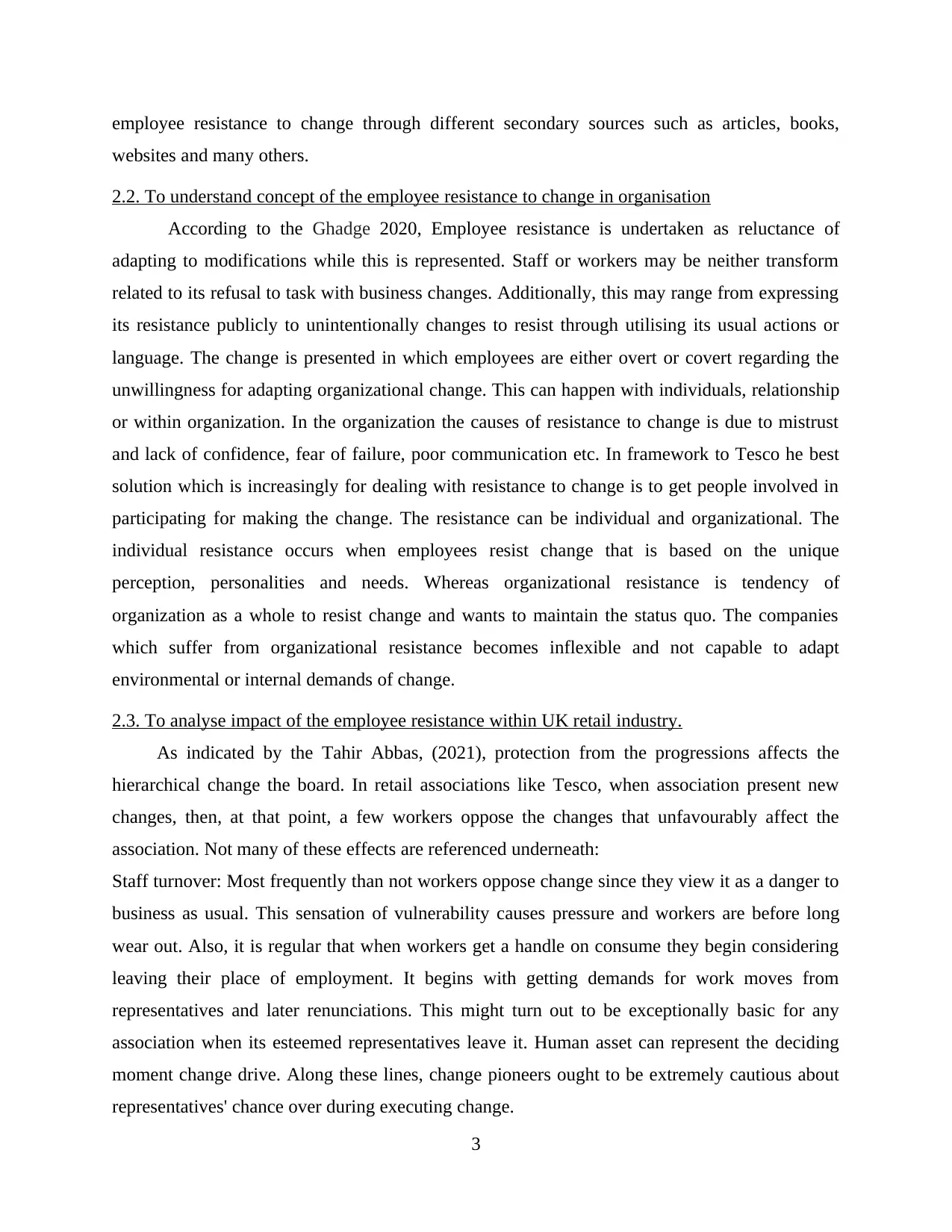
employee resistance to change through different secondary sources such as articles, books,
websites and many others.
2.2. To understand concept of the employee resistance to change in organisation
According to the Ghadge 2020, Employee resistance is undertaken as reluctance of
adapting to modifications while this is represented. Staff or workers may be neither transform
related to its refusal to task with business changes. Additionally, this may range from expressing
its resistance publicly to unintentionally changes to resist through utilising its usual actions or
language. The change is presented in which employees are either overt or covert regarding the
unwillingness for adapting organizational change. This can happen with individuals, relationship
or within organization. In the organization the causes of resistance to change is due to mistrust
and lack of confidence, fear of failure, poor communication etc. In framework to Tesco he best
solution which is increasingly for dealing with resistance to change is to get people involved in
participating for making the change. The resistance can be individual and organizational. The
individual resistance occurs when employees resist change that is based on the unique
perception, personalities and needs. Whereas organizational resistance is tendency of
organization as a whole to resist change and wants to maintain the status quo. The companies
which suffer from organizational resistance becomes inflexible and not capable to adapt
environmental or internal demands of change.
2.3. To analyse impact of the employee resistance within UK retail industry.
As indicated by the Tahir Abbas, (2021), protection from the progressions affects the
hierarchical change the board. In retail associations like Tesco, when association present new
changes, then, at that point, a few workers oppose the changes that unfavourably affect the
association. Not many of these effects are referenced underneath:
Staff turnover: Most frequently than not workers oppose change since they view it as a danger to
business as usual. This sensation of vulnerability causes pressure and workers are before long
wear out. Also, it is regular that when workers get a handle on consume they begin considering
leaving their place of employment. It begins with getting demands for work moves from
representatives and later renunciations. This might turn out to be exceptionally basic for any
association when its esteemed representatives leave it. Human asset can represent the deciding
moment change drive. Along these lines, change pioneers ought to be extremely cautious about
representatives' chance over during executing change.
3
websites and many others.
2.2. To understand concept of the employee resistance to change in organisation
According to the Ghadge 2020, Employee resistance is undertaken as reluctance of
adapting to modifications while this is represented. Staff or workers may be neither transform
related to its refusal to task with business changes. Additionally, this may range from expressing
its resistance publicly to unintentionally changes to resist through utilising its usual actions or
language. The change is presented in which employees are either overt or covert regarding the
unwillingness for adapting organizational change. This can happen with individuals, relationship
or within organization. In the organization the causes of resistance to change is due to mistrust
and lack of confidence, fear of failure, poor communication etc. In framework to Tesco he best
solution which is increasingly for dealing with resistance to change is to get people involved in
participating for making the change. The resistance can be individual and organizational. The
individual resistance occurs when employees resist change that is based on the unique
perception, personalities and needs. Whereas organizational resistance is tendency of
organization as a whole to resist change and wants to maintain the status quo. The companies
which suffer from organizational resistance becomes inflexible and not capable to adapt
environmental or internal demands of change.
2.3. To analyse impact of the employee resistance within UK retail industry.
As indicated by the Tahir Abbas, (2021), protection from the progressions affects the
hierarchical change the board. In retail associations like Tesco, when association present new
changes, then, at that point, a few workers oppose the changes that unfavourably affect the
association. Not many of these effects are referenced underneath:
Staff turnover: Most frequently than not workers oppose change since they view it as a danger to
business as usual. This sensation of vulnerability causes pressure and workers are before long
wear out. Also, it is regular that when workers get a handle on consume they begin considering
leaving their place of employment. It begins with getting demands for work moves from
representatives and later renunciations. This might turn out to be exceptionally basic for any
association when its esteemed representatives leave it. Human asset can represent the deciding
moment change drive. Along these lines, change pioneers ought to be extremely cautious about
representatives' chance over during executing change.
3
⊘ This is a preview!⊘
Do you want full access?
Subscribe today to unlock all pages.

Trusted by 1+ million students worldwide
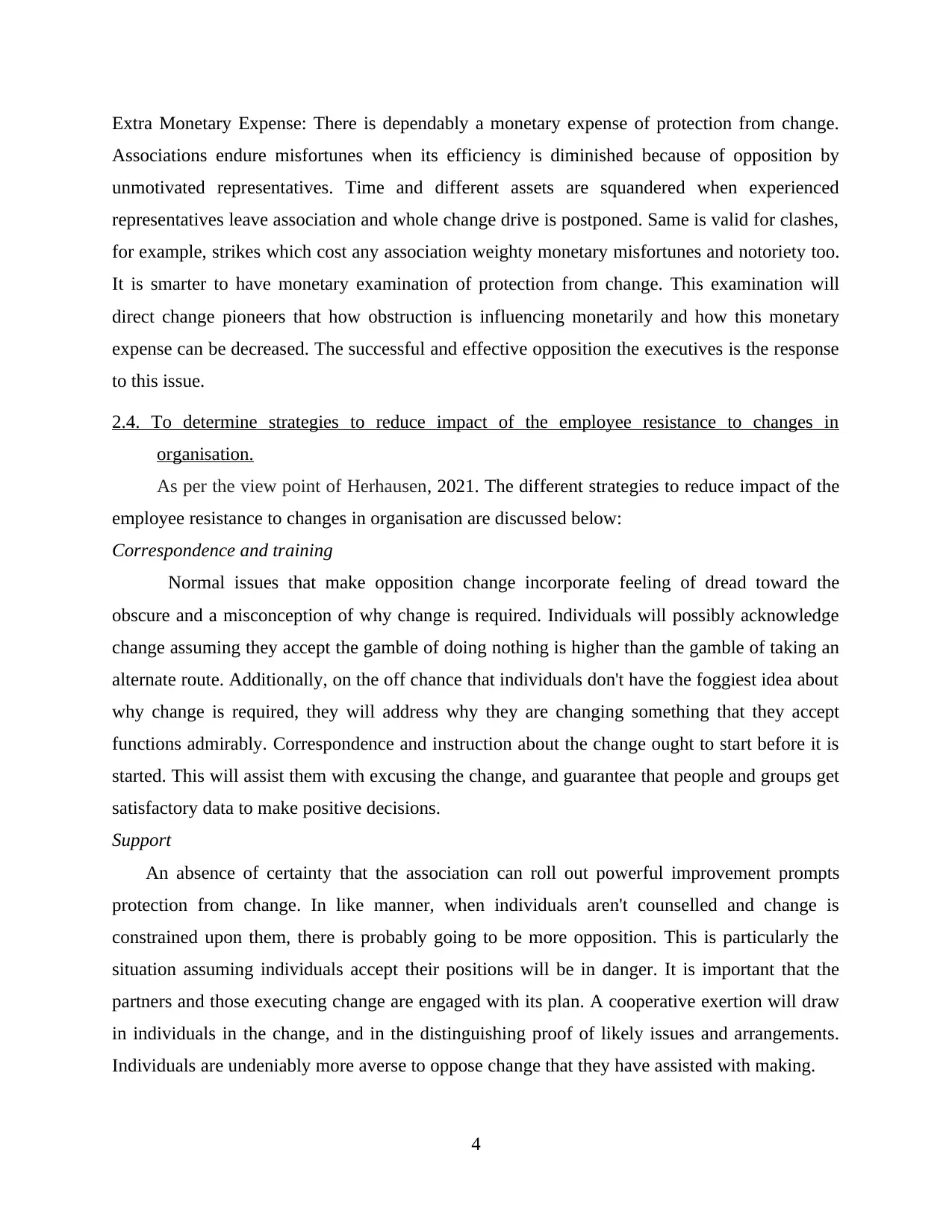
Extra Monetary Expense: There is dependably a monetary expense of protection from change.
Associations endure misfortunes when its efficiency is diminished because of opposition by
unmotivated representatives. Time and different assets are squandered when experienced
representatives leave association and whole change drive is postponed. Same is valid for clashes,
for example, strikes which cost any association weighty monetary misfortunes and notoriety too.
It is smarter to have monetary examination of protection from change. This examination will
direct change pioneers that how obstruction is influencing monetarily and how this monetary
expense can be decreased. The successful and effective opposition the executives is the response
to this issue.
2.4. To determine strategies to reduce impact of the employee resistance to changes in
organisation.
As per the view point of Herhausen, 2021. The different strategies to reduce impact of the
employee resistance to changes in organisation are discussed below:
Correspondence and training
Normal issues that make opposition change incorporate feeling of dread toward the
obscure and a misconception of why change is required. Individuals will possibly acknowledge
change assuming they accept the gamble of doing nothing is higher than the gamble of taking an
alternate route. Additionally, on the off chance that individuals don't have the foggiest idea about
why change is required, they will address why they are changing something that they accept
functions admirably. Correspondence and instruction about the change ought to start before it is
started. This will assist them with excusing the change, and guarantee that people and groups get
satisfactory data to make positive decisions.
Support
An absence of certainty that the association can roll out powerful improvement prompts
protection from change. In like manner, when individuals aren't counselled and change is
constrained upon them, there is probably going to be more opposition. This is particularly the
situation assuming individuals accept their positions will be in danger. It is important that the
partners and those executing change are engaged with its plan. A cooperative exertion will draw
in individuals in the change, and in the distinguishing proof of likely issues and arrangements.
Individuals are undeniably more averse to oppose change that they have assisted with making.
4
Associations endure misfortunes when its efficiency is diminished because of opposition by
unmotivated representatives. Time and different assets are squandered when experienced
representatives leave association and whole change drive is postponed. Same is valid for clashes,
for example, strikes which cost any association weighty monetary misfortunes and notoriety too.
It is smarter to have monetary examination of protection from change. This examination will
direct change pioneers that how obstruction is influencing monetarily and how this monetary
expense can be decreased. The successful and effective opposition the executives is the response
to this issue.
2.4. To determine strategies to reduce impact of the employee resistance to changes in
organisation.
As per the view point of Herhausen, 2021. The different strategies to reduce impact of the
employee resistance to changes in organisation are discussed below:
Correspondence and training
Normal issues that make opposition change incorporate feeling of dread toward the
obscure and a misconception of why change is required. Individuals will possibly acknowledge
change assuming they accept the gamble of doing nothing is higher than the gamble of taking an
alternate route. Additionally, on the off chance that individuals don't have the foggiest idea about
why change is required, they will address why they are changing something that they accept
functions admirably. Correspondence and instruction about the change ought to start before it is
started. This will assist them with excusing the change, and guarantee that people and groups get
satisfactory data to make positive decisions.
Support
An absence of certainty that the association can roll out powerful improvement prompts
protection from change. In like manner, when individuals aren't counselled and change is
constrained upon them, there is probably going to be more opposition. This is particularly the
situation assuming individuals accept their positions will be in danger. It is important that the
partners and those executing change are engaged with its plan. A cooperative exertion will draw
in individuals in the change, and in the distinguishing proof of likely issues and arrangements.
Individuals are undeniably more averse to oppose change that they have assisted with making.
4
Paraphrase This Document
Need a fresh take? Get an instant paraphrase of this document with our AI Paraphraser
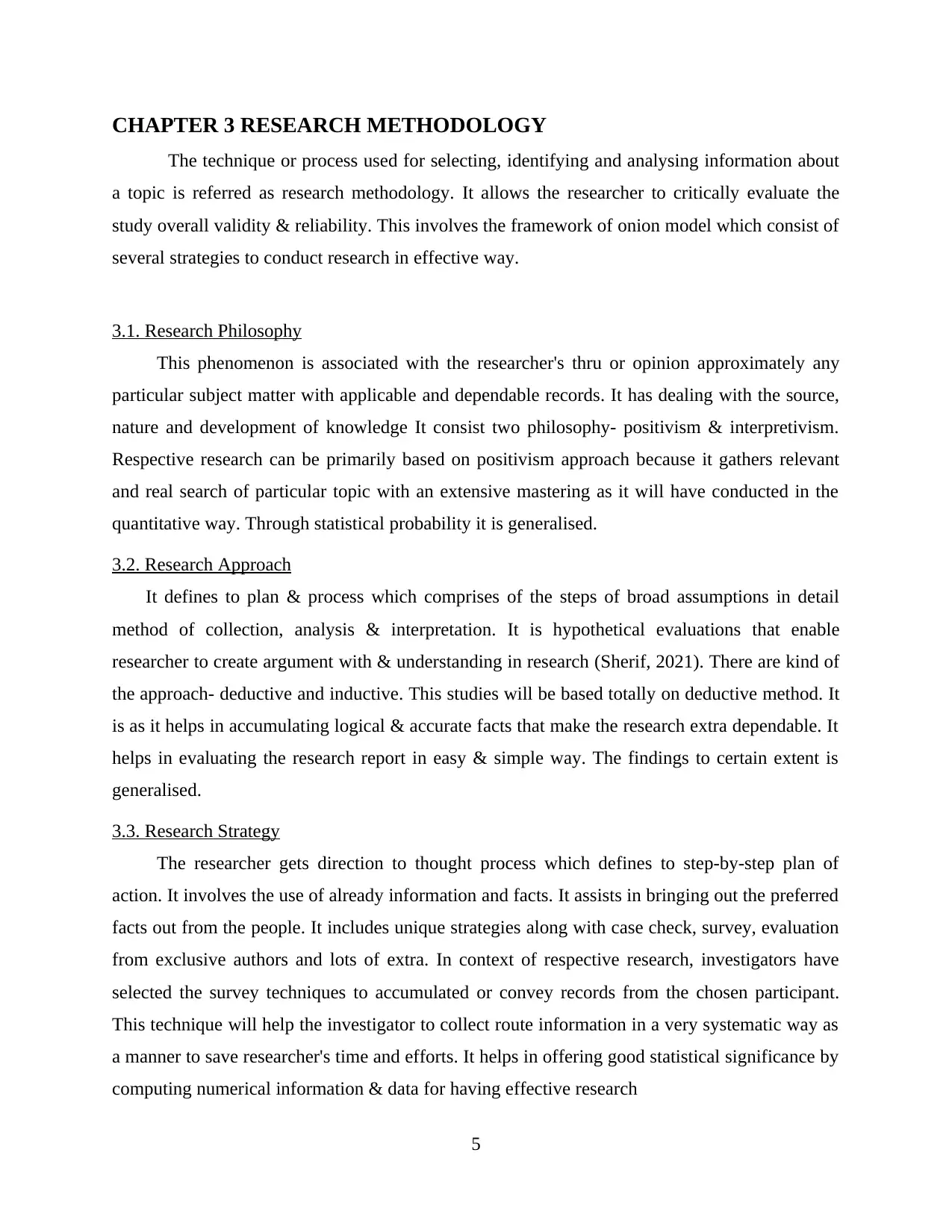
CHAPTER 3 RESEARCH METHODOLOGY
The technique or process used for selecting, identifying and analysing information about
a topic is referred as research methodology. It allows the researcher to critically evaluate the
study overall validity & reliability. This involves the framework of onion model which consist of
several strategies to conduct research in effective way.
3.1. Research Philosophy
This phenomenon is associated with the researcher's thru or opinion approximately any
particular subject matter with applicable and dependable records. It has dealing with the source,
nature and development of knowledge It consist two philosophy- positivism & interpretivism.
Respective research can be primarily based on positivism approach because it gathers relevant
and real search of particular topic with an extensive mastering as it will have conducted in the
quantitative way. Through statistical probability it is generalised.
3.2. Research Approach
It defines to plan & process which comprises of the steps of broad assumptions in detail
method of collection, analysis & interpretation. It is hypothetical evaluations that enable
researcher to create argument with & understanding in research (Sherif, 2021). There are kind of
the approach- deductive and inductive. This studies will be based totally on deductive method. It
is as it helps in accumulating logical & accurate facts that make the research extra dependable. It
helps in evaluating the research report in easy & simple way. The findings to certain extent is
generalised.
3.3. Research Strategy
The researcher gets direction to thought process which defines to step-by-step plan of
action. It involves the use of already information and facts. It assists in bringing out the preferred
facts out from the people. It includes unique strategies along with case check, survey, evaluation
from exclusive authors and lots of extra. In context of respective research, investigators have
selected the survey techniques to accumulated or convey records from the chosen participant.
This technique will help the investigator to collect route information in a very systematic way as
a manner to save researcher's time and efforts. It helps in offering good statistical significance by
computing numerical information & data for having effective research
5
The technique or process used for selecting, identifying and analysing information about
a topic is referred as research methodology. It allows the researcher to critically evaluate the
study overall validity & reliability. This involves the framework of onion model which consist of
several strategies to conduct research in effective way.
3.1. Research Philosophy
This phenomenon is associated with the researcher's thru or opinion approximately any
particular subject matter with applicable and dependable records. It has dealing with the source,
nature and development of knowledge It consist two philosophy- positivism & interpretivism.
Respective research can be primarily based on positivism approach because it gathers relevant
and real search of particular topic with an extensive mastering as it will have conducted in the
quantitative way. Through statistical probability it is generalised.
3.2. Research Approach
It defines to plan & process which comprises of the steps of broad assumptions in detail
method of collection, analysis & interpretation. It is hypothetical evaluations that enable
researcher to create argument with & understanding in research (Sherif, 2021). There are kind of
the approach- deductive and inductive. This studies will be based totally on deductive method. It
is as it helps in accumulating logical & accurate facts that make the research extra dependable. It
helps in evaluating the research report in easy & simple way. The findings to certain extent is
generalised.
3.3. Research Strategy
The researcher gets direction to thought process which defines to step-by-step plan of
action. It involves the use of already information and facts. It assists in bringing out the preferred
facts out from the people. It includes unique strategies along with case check, survey, evaluation
from exclusive authors and lots of extra. In context of respective research, investigators have
selected the survey techniques to accumulated or convey records from the chosen participant.
This technique will help the investigator to collect route information in a very systematic way as
a manner to save researcher's time and efforts. It helps in offering good statistical significance by
computing numerical information & data for having effective research
5
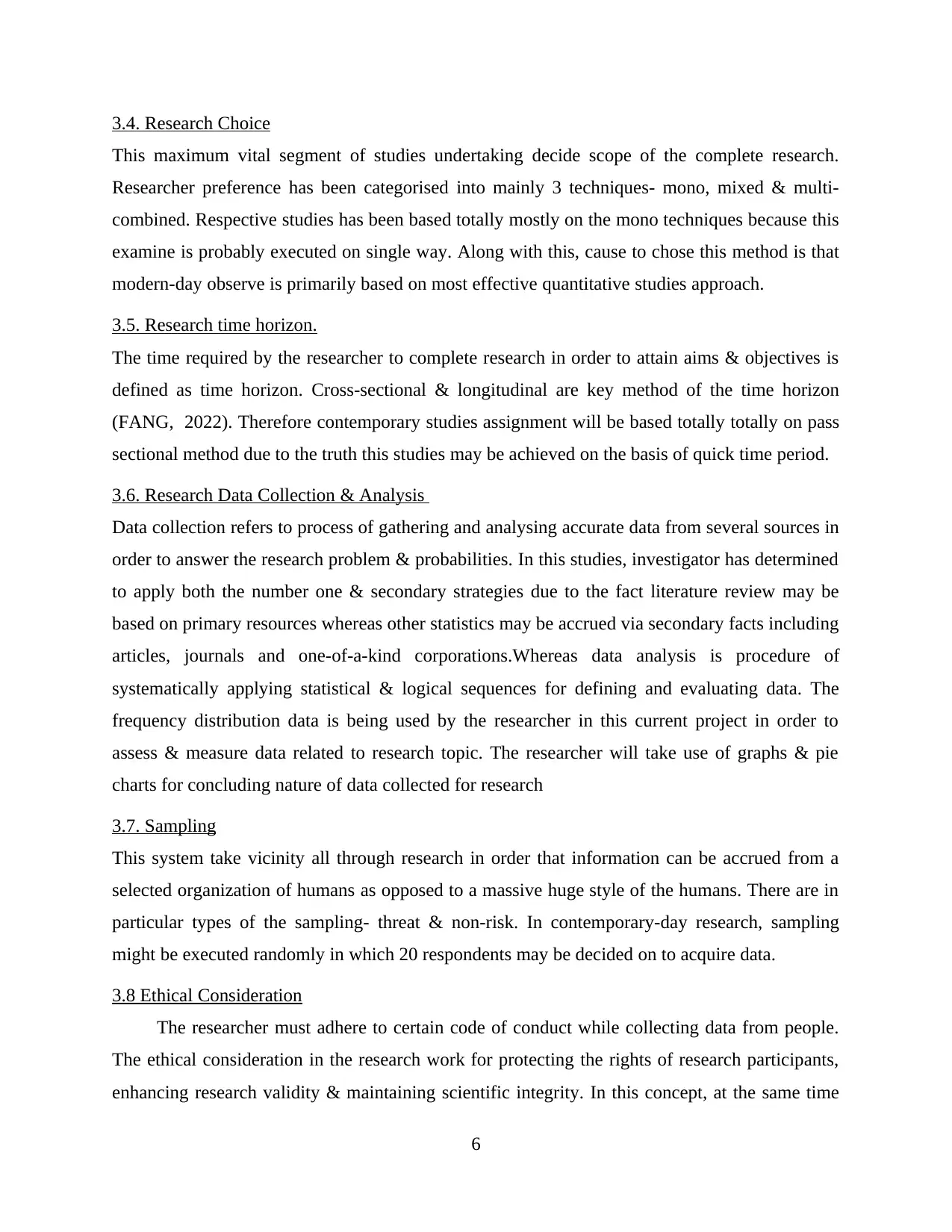
3.4. Research Choice
This maximum vital segment of studies undertaking decide scope of the complete research.
Researcher preference has been categorised into mainly 3 techniques- mono, mixed & multi-
combined. Respective studies has been based totally mostly on the mono techniques because this
examine is probably executed on single way. Along with this, cause to chose this method is that
modern-day observe is primarily based on most effective quantitative studies approach.
3.5. Research time horizon.
The time required by the researcher to complete research in order to attain aims & objectives is
defined as time horizon. Cross-sectional & longitudinal are key method of the time horizon
(FANG, 2022). Therefore contemporary studies assignment will be based totally totally on pass
sectional method due to the truth this studies may be achieved on the basis of quick time period.
3.6. Research Data Collection & Analysis
Data collection refers to process of gathering and analysing accurate data from several sources in
order to answer the research problem & probabilities. In this studies, investigator has determined
to apply both the number one & secondary strategies due to the fact literature review may be
based on primary resources whereas other statistics may be accrued via secondary facts including
articles, journals and one-of-a-kind corporations.Whereas data analysis is procedure of
systematically applying statistical & logical sequences for defining and evaluating data. The
frequency distribution data is being used by the researcher in this current project in order to
assess & measure data related to research topic. The researcher will take use of graphs & pie
charts for concluding nature of data collected for research
3.7. Sampling
This system take vicinity all through research in order that information can be accrued from a
selected organization of humans as opposed to a massive huge style of the humans. There are in
particular types of the sampling- threat & non-risk. In contemporary-day research, sampling
might be executed randomly in which 20 respondents may be decided on to acquire data.
3.8 Ethical Consideration
The researcher must adhere to certain code of conduct while collecting data from people.
The ethical consideration in the research work for protecting the rights of research participants,
enhancing research validity & maintaining scientific integrity. In this concept, at the same time
6
This maximum vital segment of studies undertaking decide scope of the complete research.
Researcher preference has been categorised into mainly 3 techniques- mono, mixed & multi-
combined. Respective studies has been based totally mostly on the mono techniques because this
examine is probably executed on single way. Along with this, cause to chose this method is that
modern-day observe is primarily based on most effective quantitative studies approach.
3.5. Research time horizon.
The time required by the researcher to complete research in order to attain aims & objectives is
defined as time horizon. Cross-sectional & longitudinal are key method of the time horizon
(FANG, 2022). Therefore contemporary studies assignment will be based totally totally on pass
sectional method due to the truth this studies may be achieved on the basis of quick time period.
3.6. Research Data Collection & Analysis
Data collection refers to process of gathering and analysing accurate data from several sources in
order to answer the research problem & probabilities. In this studies, investigator has determined
to apply both the number one & secondary strategies due to the fact literature review may be
based on primary resources whereas other statistics may be accrued via secondary facts including
articles, journals and one-of-a-kind corporations.Whereas data analysis is procedure of
systematically applying statistical & logical sequences for defining and evaluating data. The
frequency distribution data is being used by the researcher in this current project in order to
assess & measure data related to research topic. The researcher will take use of graphs & pie
charts for concluding nature of data collected for research
3.7. Sampling
This system take vicinity all through research in order that information can be accrued from a
selected organization of humans as opposed to a massive huge style of the humans. There are in
particular types of the sampling- threat & non-risk. In contemporary-day research, sampling
might be executed randomly in which 20 respondents may be decided on to acquire data.
3.8 Ethical Consideration
The researcher must adhere to certain code of conduct while collecting data from people.
The ethical consideration in the research work for protecting the rights of research participants,
enhancing research validity & maintaining scientific integrity. In this concept, at the same time
6
⊘ This is a preview!⊘
Do you want full access?
Subscribe today to unlock all pages.

Trusted by 1+ million students worldwide
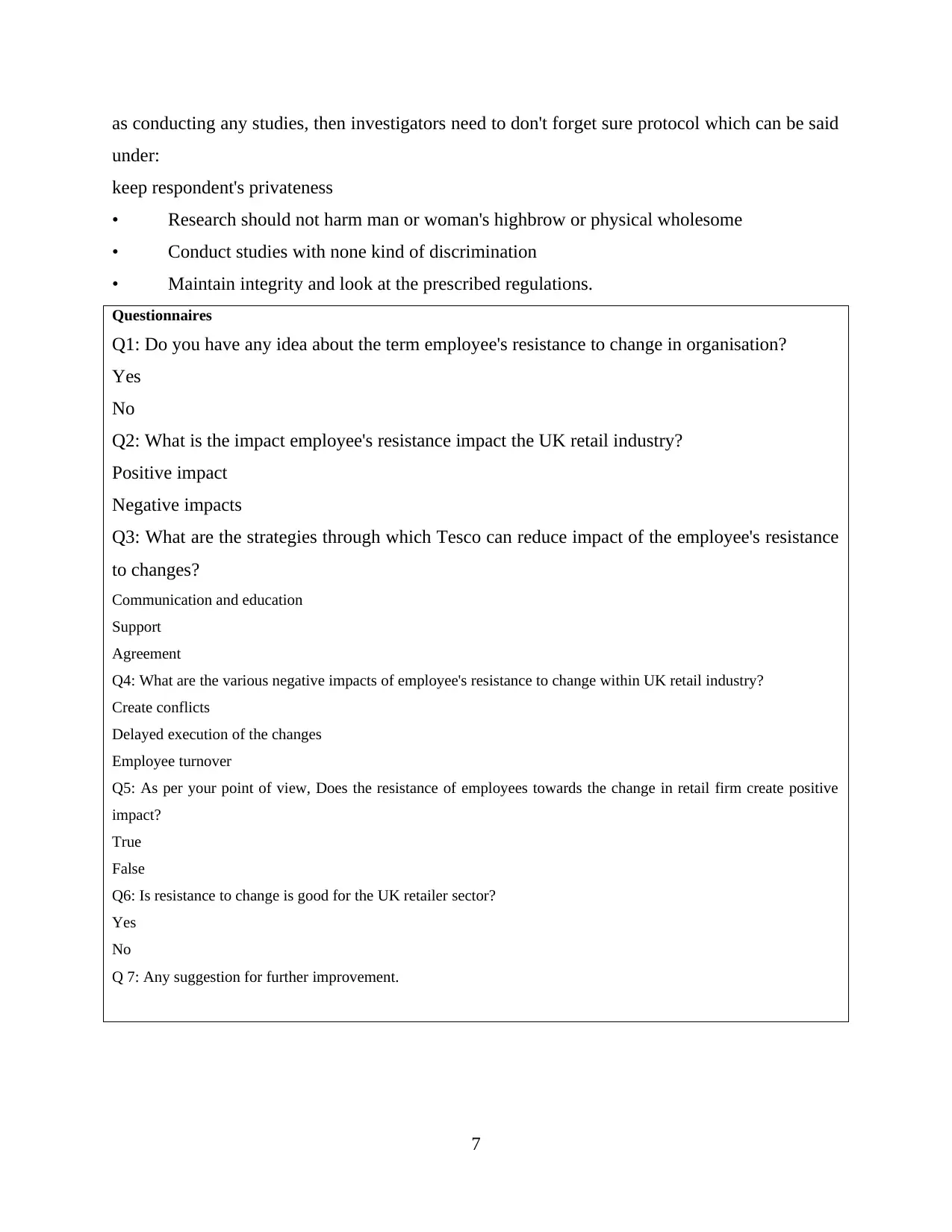
as conducting any studies, then investigators need to don't forget sure protocol which can be said
under:
keep respondent's privateness
• Research should not harm man or woman's highbrow or physical wholesome
• Conduct studies with none kind of discrimination
• Maintain integrity and look at the prescribed regulations.
Questionnaires
Q1: Do you have any idea about the term employee's resistance to change in organisation?
Yes
No
Q2: What is the impact employee's resistance impact the UK retail industry?
Positive impact
Negative impacts
Q3: What are the strategies through which Tesco can reduce impact of the employee's resistance
to changes?
Communication and education
Support
Agreement
Q4: What are the various negative impacts of employee's resistance to change within UK retail industry?
Create conflicts
Delayed execution of the changes
Employee turnover
Q5: As per your point of view, Does the resistance of employees towards the change in retail firm create positive
impact?
True
False
Q6: Is resistance to change is good for the UK retailer sector?
Yes
No
Q 7: Any suggestion for further improvement.
7
under:
keep respondent's privateness
• Research should not harm man or woman's highbrow or physical wholesome
• Conduct studies with none kind of discrimination
• Maintain integrity and look at the prescribed regulations.
Questionnaires
Q1: Do you have any idea about the term employee's resistance to change in organisation?
Yes
No
Q2: What is the impact employee's resistance impact the UK retail industry?
Positive impact
Negative impacts
Q3: What are the strategies through which Tesco can reduce impact of the employee's resistance
to changes?
Communication and education
Support
Agreement
Q4: What are the various negative impacts of employee's resistance to change within UK retail industry?
Create conflicts
Delayed execution of the changes
Employee turnover
Q5: As per your point of view, Does the resistance of employees towards the change in retail firm create positive
impact?
True
False
Q6: Is resistance to change is good for the UK retailer sector?
Yes
No
Q 7: Any suggestion for further improvement.
7
Paraphrase This Document
Need a fresh take? Get an instant paraphrase of this document with our AI Paraphraser
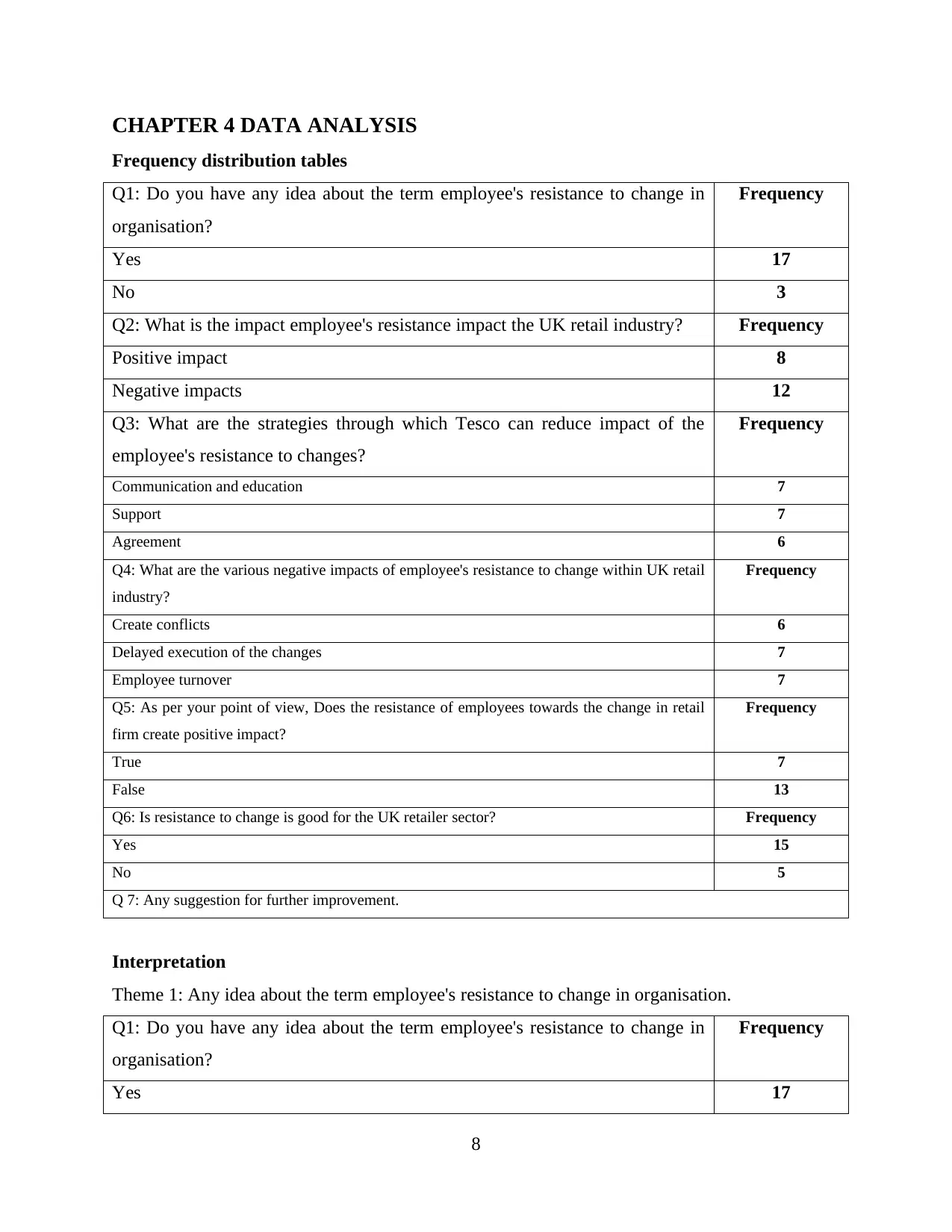
CHAPTER 4 DATA ANALYSIS
Frequency distribution tables
Q1: Do you have any idea about the term employee's resistance to change in
organisation?
Frequency
Yes 17
No 3
Q2: What is the impact employee's resistance impact the UK retail industry? Frequency
Positive impact 8
Negative impacts 12
Q3: What are the strategies through which Tesco can reduce impact of the
employee's resistance to changes?
Frequency
Communication and education 7
Support 7
Agreement 6
Q4: What are the various negative impacts of employee's resistance to change within UK retail
industry?
Frequency
Create conflicts 6
Delayed execution of the changes 7
Employee turnover 7
Q5: As per your point of view, Does the resistance of employees towards the change in retail
firm create positive impact?
Frequency
True 7
False 13
Q6: Is resistance to change is good for the UK retailer sector? Frequency
Yes 15
No 5
Q 7: Any suggestion for further improvement.
Interpretation
Theme 1: Any idea about the term employee's resistance to change in organisation.
Q1: Do you have any idea about the term employee's resistance to change in
organisation?
Frequency
Yes 17
8
Frequency distribution tables
Q1: Do you have any idea about the term employee's resistance to change in
organisation?
Frequency
Yes 17
No 3
Q2: What is the impact employee's resistance impact the UK retail industry? Frequency
Positive impact 8
Negative impacts 12
Q3: What are the strategies through which Tesco can reduce impact of the
employee's resistance to changes?
Frequency
Communication and education 7
Support 7
Agreement 6
Q4: What are the various negative impacts of employee's resistance to change within UK retail
industry?
Frequency
Create conflicts 6
Delayed execution of the changes 7
Employee turnover 7
Q5: As per your point of view, Does the resistance of employees towards the change in retail
firm create positive impact?
Frequency
True 7
False 13
Q6: Is resistance to change is good for the UK retailer sector? Frequency
Yes 15
No 5
Q 7: Any suggestion for further improvement.
Interpretation
Theme 1: Any idea about the term employee's resistance to change in organisation.
Q1: Do you have any idea about the term employee's resistance to change in
organisation?
Frequency
Yes 17
8
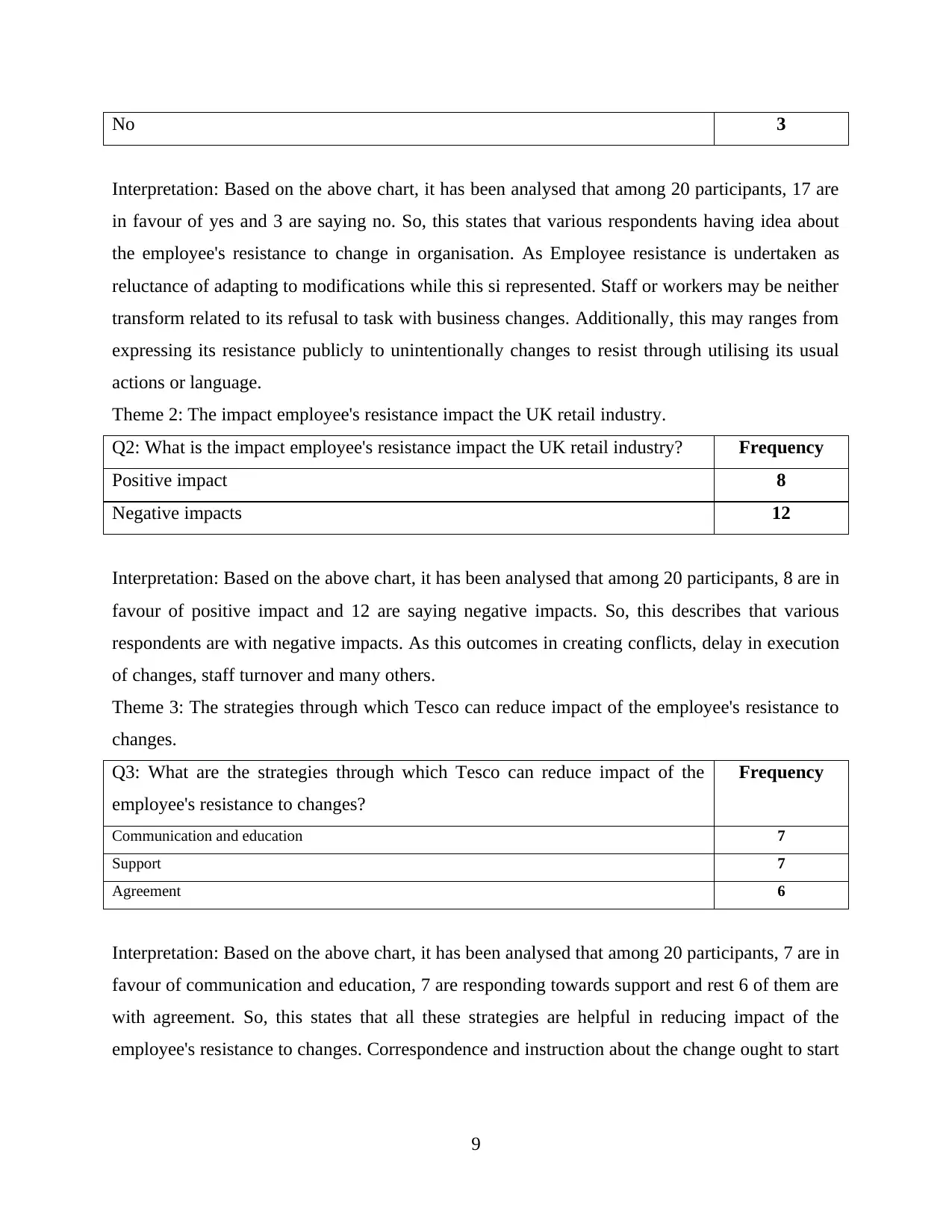
No 3
Interpretation: Based on the above chart, it has been analysed that among 20 participants, 17 are
in favour of yes and 3 are saying no. So, this states that various respondents having idea about
the employee's resistance to change in organisation. As Employee resistance is undertaken as
reluctance of adapting to modifications while this si represented. Staff or workers may be neither
transform related to its refusal to task with business changes. Additionally, this may ranges from
expressing its resistance publicly to unintentionally changes to resist through utilising its usual
actions or language.
Theme 2: The impact employee's resistance impact the UK retail industry.
Q2: What is the impact employee's resistance impact the UK retail industry? Frequency
Positive impact 8
Negative impacts 12
Interpretation: Based on the above chart, it has been analysed that among 20 participants, 8 are in
favour of positive impact and 12 are saying negative impacts. So, this describes that various
respondents are with negative impacts. As this outcomes in creating conflicts, delay in execution
of changes, staff turnover and many others.
Theme 3: The strategies through which Tesco can reduce impact of the employee's resistance to
changes.
Q3: What are the strategies through which Tesco can reduce impact of the
employee's resistance to changes?
Frequency
Communication and education 7
Support 7
Agreement 6
Interpretation: Based on the above chart, it has been analysed that among 20 participants, 7 are in
favour of communication and education, 7 are responding towards support and rest 6 of them are
with agreement. So, this states that all these strategies are helpful in reducing impact of the
employee's resistance to changes. Correspondence and instruction about the change ought to start
9
Interpretation: Based on the above chart, it has been analysed that among 20 participants, 17 are
in favour of yes and 3 are saying no. So, this states that various respondents having idea about
the employee's resistance to change in organisation. As Employee resistance is undertaken as
reluctance of adapting to modifications while this si represented. Staff or workers may be neither
transform related to its refusal to task with business changes. Additionally, this may ranges from
expressing its resistance publicly to unintentionally changes to resist through utilising its usual
actions or language.
Theme 2: The impact employee's resistance impact the UK retail industry.
Q2: What is the impact employee's resistance impact the UK retail industry? Frequency
Positive impact 8
Negative impacts 12
Interpretation: Based on the above chart, it has been analysed that among 20 participants, 8 are in
favour of positive impact and 12 are saying negative impacts. So, this describes that various
respondents are with negative impacts. As this outcomes in creating conflicts, delay in execution
of changes, staff turnover and many others.
Theme 3: The strategies through which Tesco can reduce impact of the employee's resistance to
changes.
Q3: What are the strategies through which Tesco can reduce impact of the
employee's resistance to changes?
Frequency
Communication and education 7
Support 7
Agreement 6
Interpretation: Based on the above chart, it has been analysed that among 20 participants, 7 are in
favour of communication and education, 7 are responding towards support and rest 6 of them are
with agreement. So, this states that all these strategies are helpful in reducing impact of the
employee's resistance to changes. Correspondence and instruction about the change ought to start
9
⊘ This is a preview!⊘
Do you want full access?
Subscribe today to unlock all pages.

Trusted by 1+ million students worldwide
1 out of 17
Related Documents
Your All-in-One AI-Powered Toolkit for Academic Success.
+13062052269
info@desklib.com
Available 24*7 on WhatsApp / Email
![[object Object]](/_next/static/media/star-bottom.7253800d.svg)
Unlock your academic potential
Copyright © 2020–2025 A2Z Services. All Rights Reserved. Developed and managed by ZUCOL.




